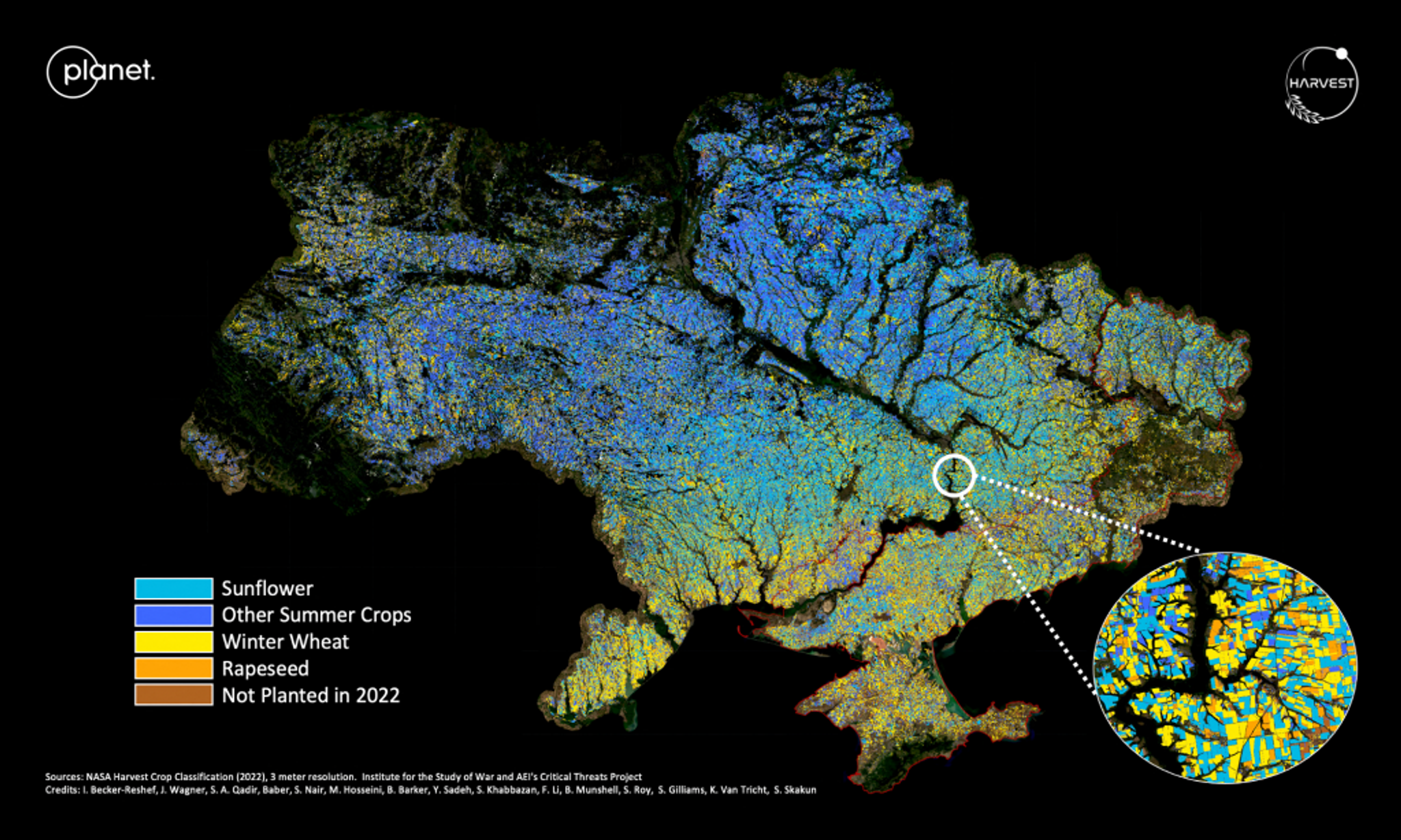Using Space to Help Feed the Hungry
A new partnership between Planet and NASA Harvest will make breakthrough food security solution widely available
When NASA Harvest researchers started analyzing fields from above on either side of the frontlines in Russia and Ukraine, they saw more than artillery pockmarked-fields with budding rows of sunflowers.
They saw a looming food security crisis that would have ripple effects beyond Europe’s breadbasket.

Crop type classification map, Ukraine, 2022 || This 2022 crop type classification map of Ukraine was produced in season with 94% accuracy at 3m resolution, validated with ~4700 ground data samples. Red boundary lines denote Russian-controlled Ukrainian territory, and the various coloration across the country denotes sunflower (light blue), winter wheat (yellow), rapeseed (orange), other summer crops (dark blue), and areas not planted (brown) as of October 2022. (Map generated courtesy of: NASA Harvest; Data courtesy of: Planet, Kyiv Polytechnic, NASA, and Institute for the Study of War).
What was striking was that they were able to harness Planet satellite basemaps, combined with other environmental, economic, and social science impact data, to see what was growing – and what wasn’t – at a field-by-field level across the entire region. Their August analysis pointed to a more optimistic outlook that more cropland than they, and other public estimates, had initially expected was both harvested and planted along both the Russian-occupied and Ukrainian-held territories. And while that didn’t solve the challenges of fertilizer price hikes, tremendous logistics challenges or numerous reports of grain theft, it did afford a more crystallized view of what the world might expect for grain and wheat in the harvest ahead.
It’s reminiscent of what the Planet-Harvest pair tackled during the COVID-19 pandemic, with the government of Togo, creating a cropland map of the entire country (delivered within 10 days of receiving the request!) allowing the government to mobilize quickly to ensure food security during the global pandemic.
And from the university researchers to the satellite taskers, they collectively recognized that there was more value to be unlocked from what they were seeing on computer screens.
It’s in that vein, then, that the two organizations collaborated in the launch of the Food Security and Agricultural Monitoring Solution, an offering aiming to deliver policy-grade agricultural monitoring and assessments of potential threats to global food security. The goal? Combine the power of timely, frequent satellite data with AI and ML modeling, domain expertise and user input to scale an assessment tool that could play a key role in anticipating and averting food shortages or disruptions, and providing key information for policy support, not just in Togo, not just in Ukraine, but globally.
“From my vantage point, combing through satellite imagery was about more than training AI models on crop fields,” said Josef Wagner, a NASA Harvest researcher critical to ongoing Ukraine food security analyses. “It’s meaningful to use those analyses to tackle real-world issues like food scarcity or even what a loaf of bread costs at the store. I hope this program has an impact that can cascade to many across the world,” added Shabarinath Nair, another NASA Harvest scientist.
“Providing data to NASA Harvest was one of our earliest humanitarian response projects we undertook at the outset of the Russo-Ukrainian War,” said Melissa Rosa, Planet’s Impact Programs Manager. “It’s incredible what they’ve done with that project, and we’re excited to see how this grows as more organizations can now benefit from the expanded accessibility.”
For more information about accessing the Food Security and Agricultural Monitoring Solution, please email food-security@planet.com.
Forward-looking Statements
Except for the historical information contained herein, the matters set forth in this blog are forward-looking statements within the meaning of the "safe harbor" provisions of the Private Securities Litigation Reform Act of 1995, including, but not limited to, the ability of Planet Labs PBC (the “Company”) to capture market opportunity and realize any of the potential benefits from current or future product enhancements, new products, or strategic partnerships and customer collaborations. Forward-looking statements are based on the Company’s management’s beliefs, as well as assumptions made by, and information currently available to them. Because such statements are based on expectations as to future events and results and are not statements of fact, actual results may differ materially from those projected. Factors which may cause actual results to differ materially from current expectations include, but are not limited to the risk factors and other disclosures about the Company and its business included in the Company's periodic reports, proxy statements, and other disclosure materials filed from time to time with the Securities and Exchange Commission (SEC) which are available online at www.sec.gov, and on the Company's website at www.planet.com. All forward-looking statements reflect the Company’s beliefs and assumptions only as of the date such statements are made. The Company undertakes no obligation to update forward-looking statements to reflect future events or circumstances.

Ready to Get Started
Connect with a member of our Sales team. We'll help you find the right products and pricing for your needs


